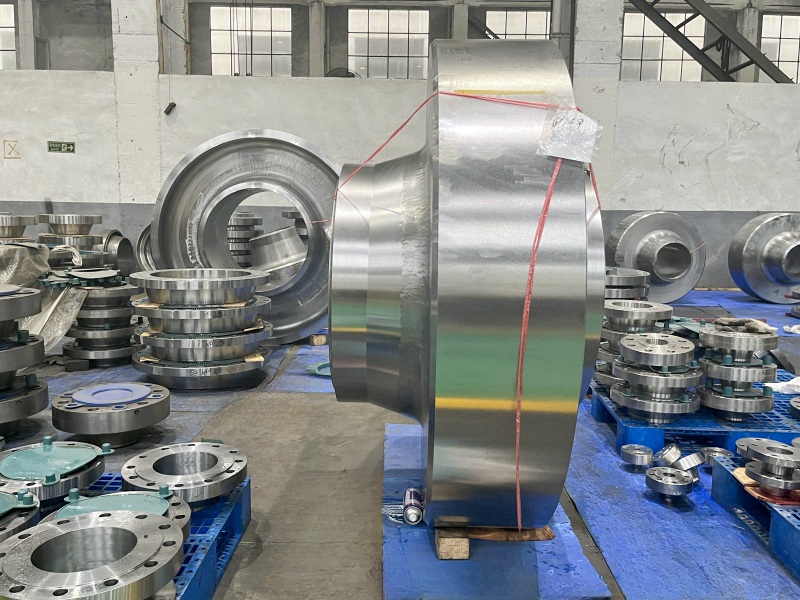
What Are You Looking For?
Pressure vessel flanges are common components of pressure vessels that serve as connections and are widely used in industrial fields such as electricity, atomic energy, petrochemicals, and light industry.
For vessel, a flange should be a unit, including a flange, gasket, connecting bolts and nuts. Its function is to combine different pressure components together, while ensuring that the connecting parts do not leak.
The main forms of failure in flange connections are stiffness failure of the joint and external leakage. The medium of pressure vessels has the characteristics of high pressure and high temperature, as well as being flammable, explosive or toxic. Once a leak occurs, serious secondary disasters will occur, posing a serious threat to the safety of pressure vessels, surrounding equipment, and personnel. Therefore, the design and selection of vessel flanges should prioritize the overall sealing performance.

Sealing form of pressure vessel flange:
a.Forced sealing.
By tightening the connecting bolts between the end cover and the cylinder flange and other forced methods, the sealing surface is pressed tightly to achieve the purpose of sealing, such as flat gasket sealing, Cachaly seal, etc.
b.Self tightening seal.
Utilize the pressure of the medium inside the vessel to generate compression force on the sealing face to achieve the sealing purpose. Its sealing force increases with the increase of medium pressure. Therefore, it can maintain reliable sealing performance even under high pressure, such as combination seals, O-ring seals, C-ring seals, B-ring seals, octagonal and elliptical gasket seals, wedge seals, flat gasket self tightening seals, wood seals, nitrogen type seals, etc.
c.Semi self sealing.
By utilizing both the pressure of the medium inside the container and the connection of fasteners, the sealing surface is compressed to achieve the purpose of sealing, such as double cone sealing.
The working principle of pressure vessel flanges is:
When the flange bolt is subjected to pre tightening force, the bolt force compresses the gasket through the flange ring, forcing the flange gasket to undergo compression deformation. When the bolt force reaches a certain value, it forces the flange sealing surface and the unevenness on the gasket to be filled with the deformation of the gasket, creating initial sealing conditions to prevent fluid medium leakage.
At this point, the compression force on the effective sealing area per unit of the gasket is called the initial sealing specific pressure of the gasket. When the equipment or pipeline is subjected to medium pressure, the bolt is stretched due to tensile stress, and the flange sealing surface moves in the direction of separation from each other. The compression force between the sealing face and the gasket decreases, and the compression force of the gasket decreases, resulting in a decrease in the pre-tightening sealing pressure ratio.
If the sealing gasket has sufficient rebound ability at this time, and the deformation of the gasket can compensate for the separation value between the bolt and the sealing face, so that the pre-tightened sealing pressure only drops to no less than the working sealing pressure, then the flange still maintains a good sealing state. On the contrary, if the rebound ability of the gasket is insufficient, the sealing pressure drops below the working sealing pressure, and even gaps reappear at the sealing port, the seal will fail.
The factors that affect the sealing of pressure vessel flanges are as follows:
1. Bolt pre-tightening force
Appropriate pre-tightening force can ensure that the gasket can still maintain a certain sealing ratio during operation. If the pre-tightening force is too large, it will crush or extrude the gasket, thereby damaging the seal. The distribution of preload force on the gasket also affects the sealing performance. The method to ensure uniform preload force distribution is to increase the number of bolts while meeting the space required for tightening and disassembling the bolts.
2. Sealing performance of gaskets
Gaskets are important components for sealing. The appropriate gasket material should reflect that the gasket can reflect the necessary elastic deformation under the appropriate pre tightening force, without being crushed or extruded. During operation, the distance between the sealing faces of the flanges is widened, and the gasket material should have sufficient rebound ability to ensure close contact between the gasket surface and the flange surface, in order to continue maintaining good sealing performance.
3. Characteristics of flange sealing surface
The type and surface performance of the flange sealing surface play a crucial role in the sealing effect. In situations with strict working conditions, concave convex surfaces and tenon groove surfaces should be used. The flatness of the flange sealing surface, the centerline and perpendicularity between the sealing surface and the flange directly affect the uniformity of the gasket's stress and the good contact between the gasket and the flange. The surface roughness of the flange sealing surface should match the requirements of the gasket, and there should be no radial knife marks or scratches on the surface, let alone surface cracks.
4. Flange stiffness
Insufficient stiffness can cause excessive warping and deformation of the flange, leading to seal failure. There are many factors that affect flange stiffness, such as increasing flange thickness, increasing flange outer diameter, etc., which can improve flange stiffness, reduce deformation, evenly transfer bolt force to the gasket, obtain uniform and sufficient sealing pressure, and improve sealing performance. The force arm that reduces the bolt force can reduce the bending moment borne by the flange, which is beneficial for sealing.
5. Operating conditions
The operating temperature, pressure, and chemical and physical properties of the medium also affect the reliability of flange connections. As the temperature increases, the viscosity of the medium decreases, and the tendency for leakage increases; High temperature increases the chemical and physical activity of the medium, resulting in corrosion and dissolution of gaskets and flanges; High temperatures can also cause creep and stress relaxation of bolts, flanges, and gaskets.
Wuxichangrun supply various piping flange and get more details from us quickly!